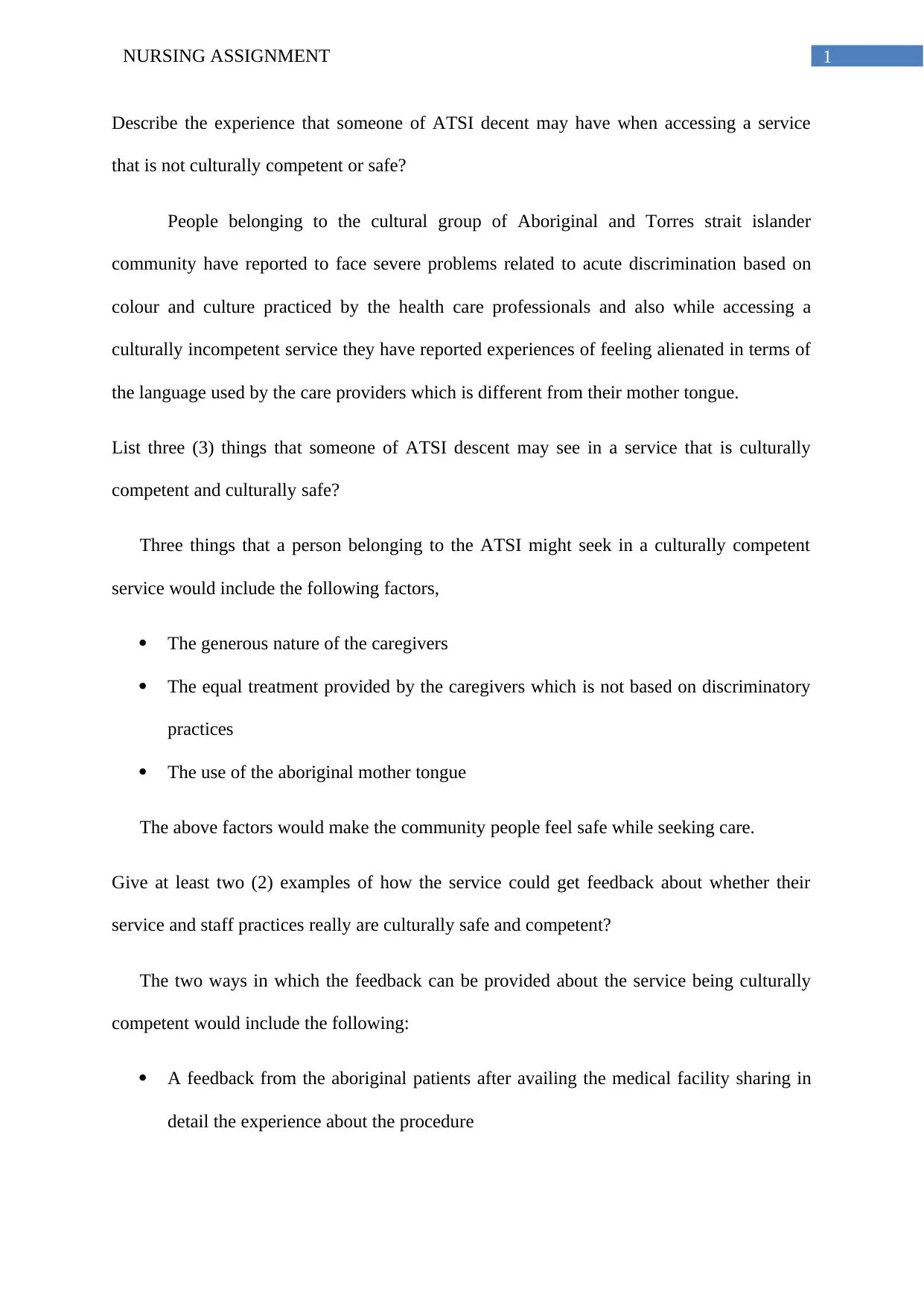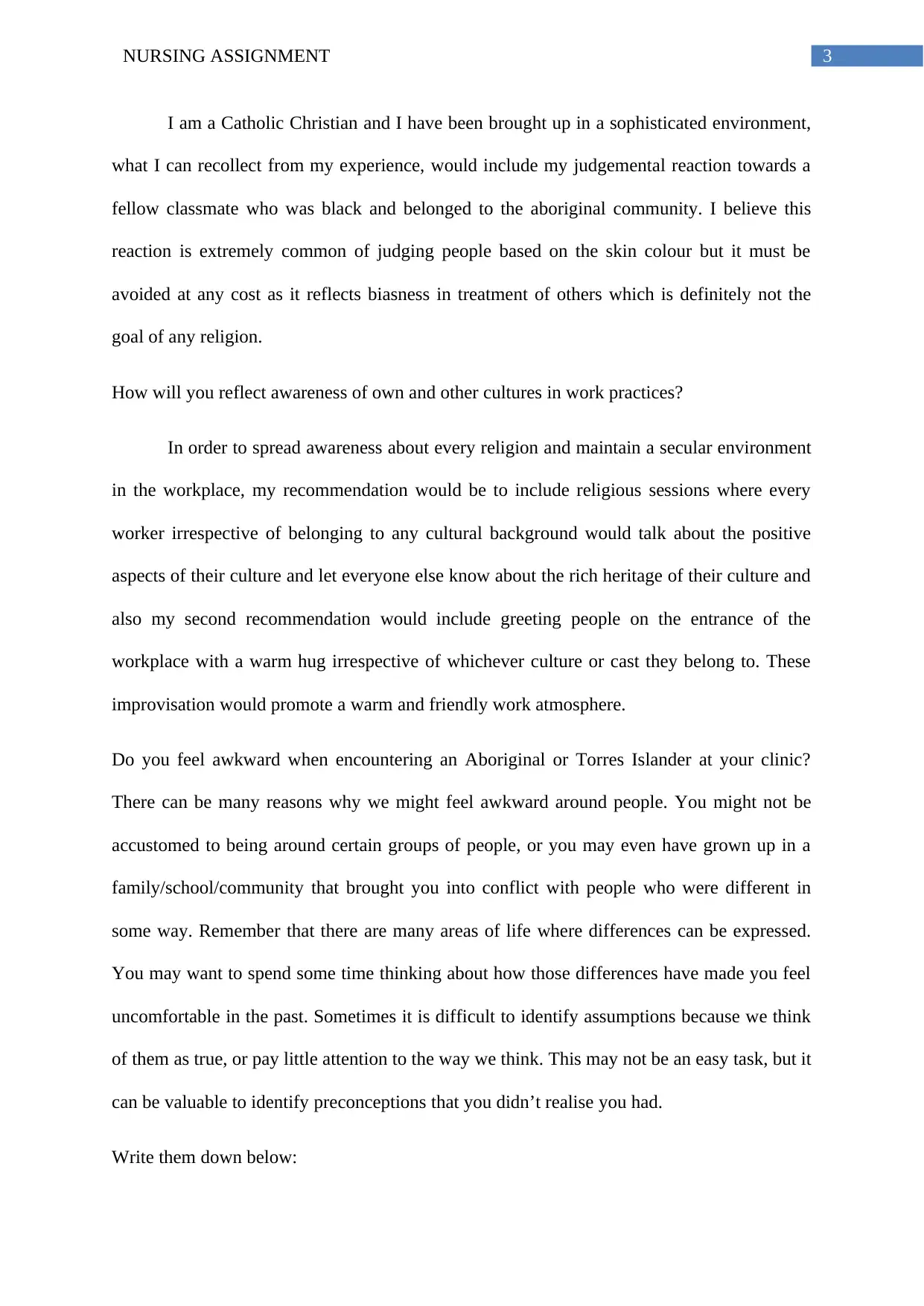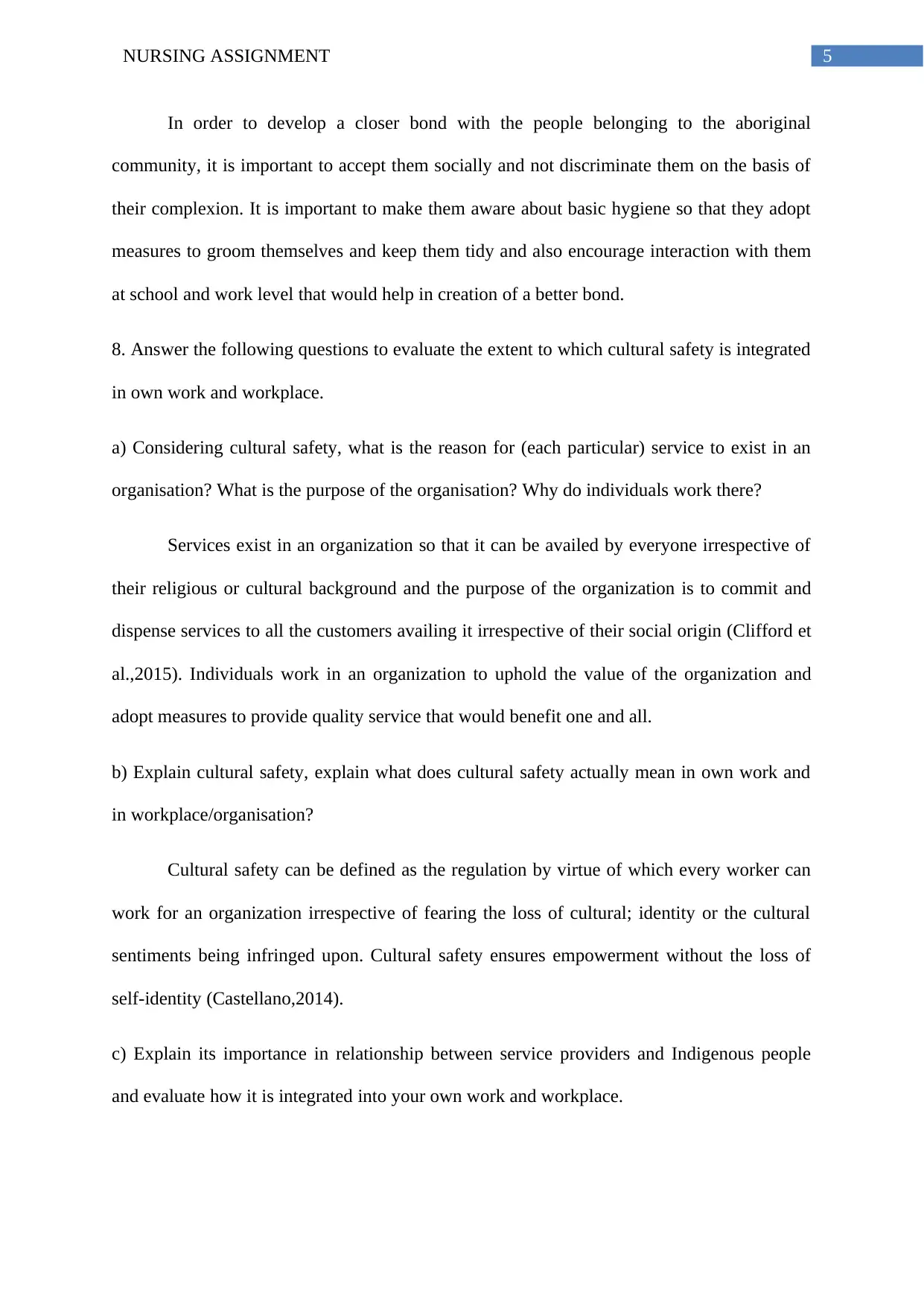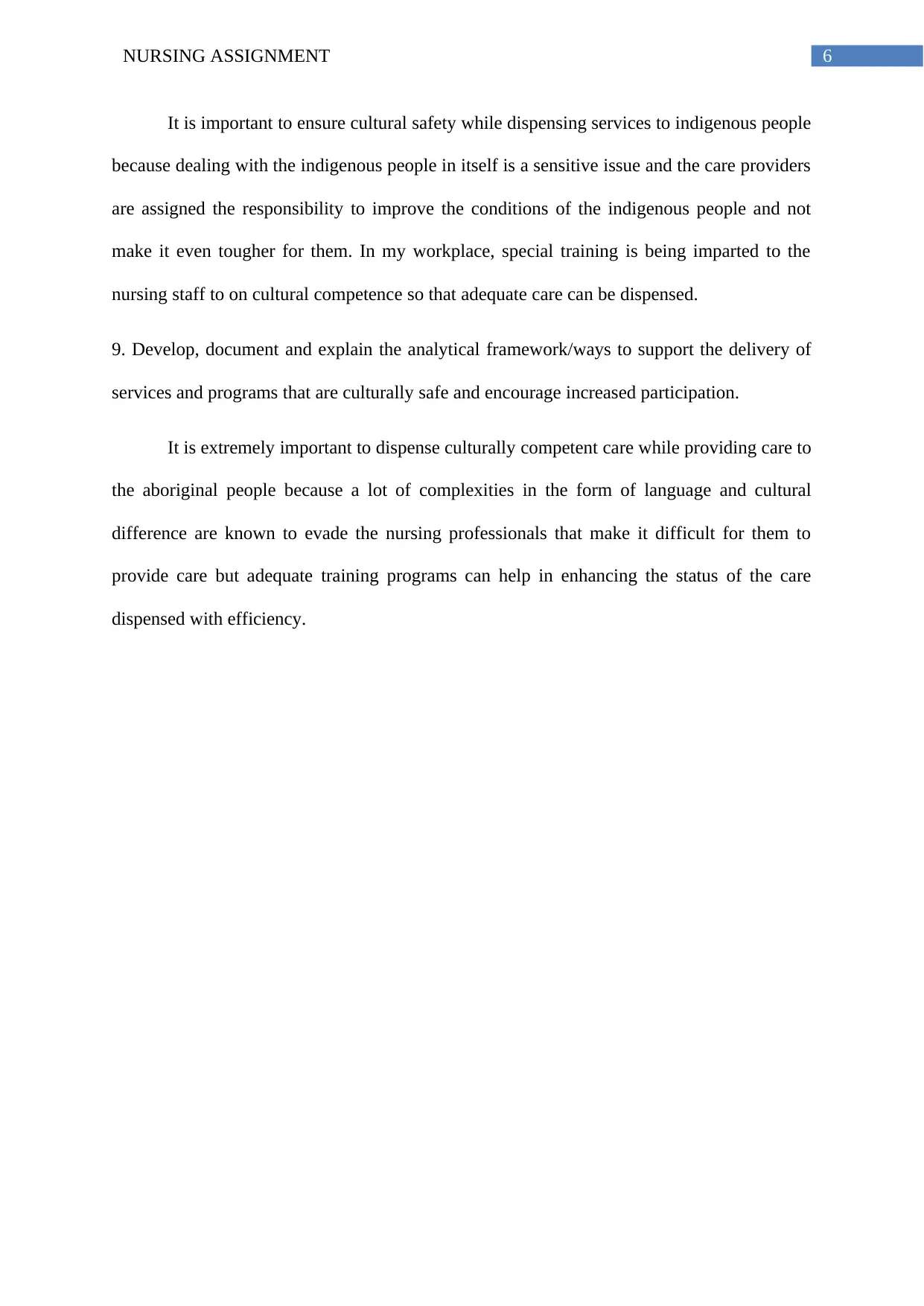CHCDIV002: Examining Cultural Safety for Aboriginal Australians
VerifiedAdded on 2023/06/08
|8
|1808
|63
Homework Assignment
AI Summary
This assignment delves into the critical aspects of cultural safety for Aboriginal and Torres Strait Islander (ATSI) people within service delivery contexts. It addresses the potential negative experiences ATSI individuals may encounter when accessing culturally incompetent services, emphasizing feelings of alienation due to language barriers and discriminatory practices. The assignment identifies key elements of culturally competent services, such as caregiver generosity, equitable treatment, and the use of Aboriginal languages. It also explores methods for gathering feedback to ensure cultural safety, including patient feedback and tracking ATSI patient numbers. Furthermore, it examines the legislative context supporting cultural safety, particularly the Aboriginal Culture Act 2003 and the Early Learning Framework. The concept of self-determination is discussed, with examples of how to encourage it in childcare settings. The assignment also includes a personal reflection on cultural bias and strategies for promoting cultural awareness in the workplace. Finally, it evaluates the integration of cultural safety in the workplace and proposes an analytical framework to support culturally safe service delivery, highlighting the importance of training programs to enhance cultural competence among healthcare professionals. Desklib offers a wealth of resources, including similar solved assignments and past papers, to aid students in their studies.

Running head: NURSING ASSIGNMENT
NURSING ASSIGNMENT
Name of the Student:
Name of the University:
Author Note:
NURSING ASSIGNMENT
Name of the Student:
Name of the University:
Author Note:
Paraphrase This Document
Need a fresh take? Get an instant paraphrase of this document with our AI Paraphraser

1NURSING ASSIGNMENT
Describe the experience that someone of ATSI decent may have when accessing a service
that is not culturally competent or safe?
People belonging to the cultural group of Aboriginal and Torres strait islander
community have reported to face severe problems related to acute discrimination based on
colour and culture practiced by the health care professionals and also while accessing a
culturally incompetent service they have reported experiences of feeling alienated in terms of
the language used by the care providers which is different from their mother tongue.
List three (3) things that someone of ATSI descent may see in a service that is culturally
competent and culturally safe?
Three things that a person belonging to the ATSI might seek in a culturally competent
service would include the following factors,
The generous nature of the caregivers
The equal treatment provided by the caregivers which is not based on discriminatory
practices
The use of the aboriginal mother tongue
The above factors would make the community people feel safe while seeking care.
Give at least two (2) examples of how the service could get feedback about whether their
service and staff practices really are culturally safe and competent?
The two ways in which the feedback can be provided about the service being culturally
competent would include the following:
A feedback from the aboriginal patients after availing the medical facility sharing in
detail the experience about the procedure
Describe the experience that someone of ATSI decent may have when accessing a service
that is not culturally competent or safe?
People belonging to the cultural group of Aboriginal and Torres strait islander
community have reported to face severe problems related to acute discrimination based on
colour and culture practiced by the health care professionals and also while accessing a
culturally incompetent service they have reported experiences of feeling alienated in terms of
the language used by the care providers which is different from their mother tongue.
List three (3) things that someone of ATSI descent may see in a service that is culturally
competent and culturally safe?
Three things that a person belonging to the ATSI might seek in a culturally competent
service would include the following factors,
The generous nature of the caregivers
The equal treatment provided by the caregivers which is not based on discriminatory
practices
The use of the aboriginal mother tongue
The above factors would make the community people feel safe while seeking care.
Give at least two (2) examples of how the service could get feedback about whether their
service and staff practices really are culturally safe and competent?
The two ways in which the feedback can be provided about the service being culturally
competent would include the following:
A feedback from the aboriginal patients after availing the medical facility sharing in
detail the experience about the procedure

2NURSING ASSIGNMENT
Keeping a close track on the number of aboriginal patients visiting the clinic, more
the number of patients, greater the probability of being able to provide positive
service.
Explain the legislative context for cultural safety of Aboriginal children and adult’s cultural
safety?
According to Aboriginal Culture Act,2003, the legislation has passed laws to protect
the cultural identity of the aborigines and protect their heritage and also adopt measures for
improving the living standards of them (Thackrah & Thompson,2013).
How does the Early Learning Framework support these legislative rights?
The Early Learning Framework supports the aboriginal rights by making provision for
imparting primary level education to the aboriginal children and establishing supporting units
to provide assistance to them (Herring et al.,2013).
Self-determination refers to a person’s ability to make their own decisions. Self-
determination should be a big part of how children develop their sense of identity. Give an
example of how you would encourage self-determination in a childcare activity or program.
In order to encourage self-determination in children, during a play session, each child
can be encouraged to take up small responsibilities that they should fulfil on your own. For
instance, after a car race session, each child can be encouraged to go for a toy-car washing
procedure where in the children are taking care of their own toys and trying to complete the
assigned task on their own without any help from others.
Reflection of own bias – provide an example of a time that your own cultural background and
values may have influenced the way you work or interacted with others?
Keeping a close track on the number of aboriginal patients visiting the clinic, more
the number of patients, greater the probability of being able to provide positive
service.
Explain the legislative context for cultural safety of Aboriginal children and adult’s cultural
safety?
According to Aboriginal Culture Act,2003, the legislation has passed laws to protect
the cultural identity of the aborigines and protect their heritage and also adopt measures for
improving the living standards of them (Thackrah & Thompson,2013).
How does the Early Learning Framework support these legislative rights?
The Early Learning Framework supports the aboriginal rights by making provision for
imparting primary level education to the aboriginal children and establishing supporting units
to provide assistance to them (Herring et al.,2013).
Self-determination refers to a person’s ability to make their own decisions. Self-
determination should be a big part of how children develop their sense of identity. Give an
example of how you would encourage self-determination in a childcare activity or program.
In order to encourage self-determination in children, during a play session, each child
can be encouraged to take up small responsibilities that they should fulfil on your own. For
instance, after a car race session, each child can be encouraged to go for a toy-car washing
procedure where in the children are taking care of their own toys and trying to complete the
assigned task on their own without any help from others.
Reflection of own bias – provide an example of a time that your own cultural background and
values may have influenced the way you work or interacted with others?
⊘ This is a preview!⊘
Do you want full access?
Subscribe today to unlock all pages.

Trusted by 1+ million students worldwide

3NURSING ASSIGNMENT
I am a Catholic Christian and I have been brought up in a sophisticated environment,
what I can recollect from my experience, would include my judgemental reaction towards a
fellow classmate who was black and belonged to the aboriginal community. I believe this
reaction is extremely common of judging people based on the skin colour but it must be
avoided at any cost as it reflects biasness in treatment of others which is definitely not the
goal of any religion.
How will you reflect awareness of own and other cultures in work practices?
In order to spread awareness about every religion and maintain a secular environment
in the workplace, my recommendation would be to include religious sessions where every
worker irrespective of belonging to any cultural background would talk about the positive
aspects of their culture and let everyone else know about the rich heritage of their culture and
also my second recommendation would include greeting people on the entrance of the
workplace with a warm hug irrespective of whichever culture or cast they belong to. These
improvisation would promote a warm and friendly work atmosphere.
Do you feel awkward when encountering an Aboriginal or Torres Islander at your clinic?
There can be many reasons why we might feel awkward around people. You might not be
accustomed to being around certain groups of people, or you may even have grown up in a
family/school/community that brought you into conflict with people who were different in
some way. Remember that there are many areas of life where differences can be expressed.
You may want to spend some time thinking about how those differences have made you feel
uncomfortable in the past. Sometimes it is difficult to identify assumptions because we think
of them as true, or pay little attention to the way we think. This may not be an easy task, but it
can be valuable to identify preconceptions that you didn’t realise you had.
Write them down below:
I am a Catholic Christian and I have been brought up in a sophisticated environment,
what I can recollect from my experience, would include my judgemental reaction towards a
fellow classmate who was black and belonged to the aboriginal community. I believe this
reaction is extremely common of judging people based on the skin colour but it must be
avoided at any cost as it reflects biasness in treatment of others which is definitely not the
goal of any religion.
How will you reflect awareness of own and other cultures in work practices?
In order to spread awareness about every religion and maintain a secular environment
in the workplace, my recommendation would be to include religious sessions where every
worker irrespective of belonging to any cultural background would talk about the positive
aspects of their culture and let everyone else know about the rich heritage of their culture and
also my second recommendation would include greeting people on the entrance of the
workplace with a warm hug irrespective of whichever culture or cast they belong to. These
improvisation would promote a warm and friendly work atmosphere.
Do you feel awkward when encountering an Aboriginal or Torres Islander at your clinic?
There can be many reasons why we might feel awkward around people. You might not be
accustomed to being around certain groups of people, or you may even have grown up in a
family/school/community that brought you into conflict with people who were different in
some way. Remember that there are many areas of life where differences can be expressed.
You may want to spend some time thinking about how those differences have made you feel
uncomfortable in the past. Sometimes it is difficult to identify assumptions because we think
of them as true, or pay little attention to the way we think. This may not be an easy task, but it
can be valuable to identify preconceptions that you didn’t realise you had.
Write them down below:
Paraphrase This Document
Need a fresh take? Get an instant paraphrase of this document with our AI Paraphraser

4NURSING ASSIGNMENT
Type of person you feel uncomfortable around
Aboriginal Men
How are they different from you?
They are not groomed and are black
Why do you think you feel uncomfortable around them?
I personally have no grudges against anyone but somehow their appearance really
seems dangerous to me which might be because of the way they carry themselves, unkempt
and untidy.
Do you think you feel this way as a result of the impact of the diverse practices or personal
experiences?
Yes, my feelings towards them is solely based on the influence of my cultural
background, I put in efforts to keep myself groomed and also maintain the basic hygienic
practices but the aboriginal men always carry themselves with dirty nails and unkempt hair
that makes me appalled towards their appearance.
List some similarities between yourself and this group of people
The similarities that can be listed would include the manner in which the daily chores
are carried out, the food items and the beverages consumed. The festivals celebrate provide
an equal amount of joy to me as it does to them and the pain inflicted by a syringe would
cause as much pain to me than to them.
What are some methods that you could use to understand these people better and feel more
comfortable around them? What could you do?
Type of person you feel uncomfortable around
Aboriginal Men
How are they different from you?
They are not groomed and are black
Why do you think you feel uncomfortable around them?
I personally have no grudges against anyone but somehow their appearance really
seems dangerous to me which might be because of the way they carry themselves, unkempt
and untidy.
Do you think you feel this way as a result of the impact of the diverse practices or personal
experiences?
Yes, my feelings towards them is solely based on the influence of my cultural
background, I put in efforts to keep myself groomed and also maintain the basic hygienic
practices but the aboriginal men always carry themselves with dirty nails and unkempt hair
that makes me appalled towards their appearance.
List some similarities between yourself and this group of people
The similarities that can be listed would include the manner in which the daily chores
are carried out, the food items and the beverages consumed. The festivals celebrate provide
an equal amount of joy to me as it does to them and the pain inflicted by a syringe would
cause as much pain to me than to them.
What are some methods that you could use to understand these people better and feel more
comfortable around them? What could you do?

5NURSING ASSIGNMENT
In order to develop a closer bond with the people belonging to the aboriginal
community, it is important to accept them socially and not discriminate them on the basis of
their complexion. It is important to make them aware about basic hygiene so that they adopt
measures to groom themselves and keep them tidy and also encourage interaction with them
at school and work level that would help in creation of a better bond.
8. Answer the following questions to evaluate the extent to which cultural safety is integrated
in own work and workplace.
a) Considering cultural safety, what is the reason for (each particular) service to exist in an
organisation? What is the purpose of the organisation? Why do individuals work there?
Services exist in an organization so that it can be availed by everyone irrespective of
their religious or cultural background and the purpose of the organization is to commit and
dispense services to all the customers availing it irrespective of their social origin (Clifford et
al.,2015). Individuals work in an organization to uphold the value of the organization and
adopt measures to provide quality service that would benefit one and all.
b) Explain cultural safety, explain what does cultural safety actually mean in own work and
in workplace/organisation?
Cultural safety can be defined as the regulation by virtue of which every worker can
work for an organization irrespective of fearing the loss of cultural; identity or the cultural
sentiments being infringed upon. Cultural safety ensures empowerment without the loss of
self-identity (Castellano,2014).
c) Explain its importance in relationship between service providers and Indigenous people
and evaluate how it is integrated into your own work and workplace.
In order to develop a closer bond with the people belonging to the aboriginal
community, it is important to accept them socially and not discriminate them on the basis of
their complexion. It is important to make them aware about basic hygiene so that they adopt
measures to groom themselves and keep them tidy and also encourage interaction with them
at school and work level that would help in creation of a better bond.
8. Answer the following questions to evaluate the extent to which cultural safety is integrated
in own work and workplace.
a) Considering cultural safety, what is the reason for (each particular) service to exist in an
organisation? What is the purpose of the organisation? Why do individuals work there?
Services exist in an organization so that it can be availed by everyone irrespective of
their religious or cultural background and the purpose of the organization is to commit and
dispense services to all the customers availing it irrespective of their social origin (Clifford et
al.,2015). Individuals work in an organization to uphold the value of the organization and
adopt measures to provide quality service that would benefit one and all.
b) Explain cultural safety, explain what does cultural safety actually mean in own work and
in workplace/organisation?
Cultural safety can be defined as the regulation by virtue of which every worker can
work for an organization irrespective of fearing the loss of cultural; identity or the cultural
sentiments being infringed upon. Cultural safety ensures empowerment without the loss of
self-identity (Castellano,2014).
c) Explain its importance in relationship between service providers and Indigenous people
and evaluate how it is integrated into your own work and workplace.
⊘ This is a preview!⊘
Do you want full access?
Subscribe today to unlock all pages.

Trusted by 1+ million students worldwide

6NURSING ASSIGNMENT
It is important to ensure cultural safety while dispensing services to indigenous people
because dealing with the indigenous people in itself is a sensitive issue and the care providers
are assigned the responsibility to improve the conditions of the indigenous people and not
make it even tougher for them. In my workplace, special training is being imparted to the
nursing staff to on cultural competence so that adequate care can be dispensed.
9. Develop, document and explain the analytical framework/ways to support the delivery of
services and programs that are culturally safe and encourage increased participation.
It is extremely important to dispense culturally competent care while providing care to
the aboriginal people because a lot of complexities in the form of language and cultural
difference are known to evade the nursing professionals that make it difficult for them to
provide care but adequate training programs can help in enhancing the status of the care
dispensed with efficiency.
It is important to ensure cultural safety while dispensing services to indigenous people
because dealing with the indigenous people in itself is a sensitive issue and the care providers
are assigned the responsibility to improve the conditions of the indigenous people and not
make it even tougher for them. In my workplace, special training is being imparted to the
nursing staff to on cultural competence so that adequate care can be dispensed.
9. Develop, document and explain the analytical framework/ways to support the delivery of
services and programs that are culturally safe and encourage increased participation.
It is extremely important to dispense culturally competent care while providing care to
the aboriginal people because a lot of complexities in the form of language and cultural
difference are known to evade the nursing professionals that make it difficult for them to
provide care but adequate training programs can help in enhancing the status of the care
dispensed with efficiency.
Paraphrase This Document
Need a fresh take? Get an instant paraphrase of this document with our AI Paraphraser

7NURSING ASSIGNMENT
References:
Castellano, M. B. (2014). Ethics of Aboriginal Research1. Global bioethics and human rights:
Contemporary issues, 273.
Clifford, A., McCalman, J., Bainbridge, R., & Tsey, K. (2015). Interventions to improve
cultural competency in health care for Indigenous peoples of Australia, New Zealand,
Canada and the USA: a systematic review. International Journal for Quality in Health
Care, 27(2), 89-98.
Herring, S., Spangaro, J., Lauw, M., & McNamara, L. (2013). The intersection of trauma,
racism, and cultural competence in effective work with aboriginal people: Waiting for
trust. Australian Social Work, 66(1), 104-117.
Thackrah, R., & Thompson, S. (2013). Refining the concept of cultural competence: building
on decades of progress. Medical Journal of Australia, 199(1), 35-38.
References:
Castellano, M. B. (2014). Ethics of Aboriginal Research1. Global bioethics and human rights:
Contemporary issues, 273.
Clifford, A., McCalman, J., Bainbridge, R., & Tsey, K. (2015). Interventions to improve
cultural competency in health care for Indigenous peoples of Australia, New Zealand,
Canada and the USA: a systematic review. International Journal for Quality in Health
Care, 27(2), 89-98.
Herring, S., Spangaro, J., Lauw, M., & McNamara, L. (2013). The intersection of trauma,
racism, and cultural competence in effective work with aboriginal people: Waiting for
trust. Australian Social Work, 66(1), 104-117.
Thackrah, R., & Thompson, S. (2013). Refining the concept of cultural competence: building
on decades of progress. Medical Journal of Australia, 199(1), 35-38.
1 out of 8
Related Documents
Your All-in-One AI-Powered Toolkit for Academic Success.
+13062052269
info@desklib.com
Available 24*7 on WhatsApp / Email
![[object Object]](/_next/static/media/star-bottom.7253800d.svg)
Unlock your academic potential
Copyright © 2020–2025 A2Z Services. All Rights Reserved. Developed and managed by ZUCOL.





